Interferometric Quantification of the Impact of Relative Humidity Variations on Cultural Heritage
Abstract
1. Introduction
1.1. Preventive Conservation
1.2. Coherent Interferometry: Direct Surface Monitoring for Distinct Data Aqcuisition
1.3. State of the Art
1.4. Brief Look into Fundamental Theory
Holographic Interferometry
2. Experimental Workstation
2.1. Implemented Optical Geometry
2.2. DHSPI Climate Chamber Workstation Monitoring
- The RH/T is measured in real-time with a hygrometer (accuracy ≈ 3%) and temperature logger placed inside the air-tight chamber (temperature resolution of 0.4 °C). To control the RH inside the chamber, saturated salt solutions of potassium sulphate (high RH) and silica gel as desiccant (low RH) are employed in long-term experiments.
- The mass of the wood sample (placed in a free-standing position and taped on the scale) is measured in real-time with a precision of 1 mg.
- The surface displacement of the sample along the z-axis (orthogonal to the surface) is monitored in real-time by DHSPI. The DHSPI portable device is on-axis with the sample outside the chamber and illuminates its full surface with an expanded laser beam (with expansion to cover the full size of sample).
- With respect to the laboratory temperature outside the climate chamber during the experiments, the laboratory temperature is kept relatively constant, with smooth fluctuations from a minimum of 24 °C during some nights to a maximum 28 °C during some days. These variations are gradual with very low rate of change. Commonly, the laboratory conditioning ensures a temperature variation of max ±2 °C/24 h.
3. Simulation Methodology
4. Results
4.1. Short-Term Monitoring: Rapid Dimensional Reactions
4.2. Long-Term Monitoring: Definition of Deformation Threshold Value (DTV)
- (a)
- RoD corresponds to a deformation below or at the edge of threshold value;
- (b)
- RoD corresponds to a deformation greater than the mean;
- (c)
- the RoD measurements are greater than the threshold value, but do not correspond to a distortion greater than the absolute mean.
Brief Conclusions on Long-Term RoD Dependencies
4.3. RoD Relation to Sorption Isotherms
- The RoD is clearly greater during drying. It shows the great difference between the two phenomena of drying and rehydration, linked with the hysteresis of the dynamic sorption isotherm (Figure 8).
- During drying, the RoD is greater after one hour and a half when the RH decreased faster. At the beginning of the rehydration, the RoD is more significant during the first thirty minutes, and then fell as the RH evolved more and more slowly. Therefore, the RoD seems to be correlated with the temporal derivative of the RH. The faster the RH changes, the higher the RoD is.
- This effect is better demonstrated on the data from day 2, shown in Figure 10, where two different temporal evolutions of the RH during drying can be noted.
5. Conclusions
- ➢
- A dry environment provokes higher deformation on wood.
- ➢
- Softwood exhibits higher values of displacement and rate of deformation than hardwood.
- ➢
- Thickness is a dominant parameter with thin samples, expressing higher values of RoD and displacement.
- ➢
- Density is the second dominant parameter, with wood cut not yet classified (tangential exhibits higher displacement than radial; examples have not been shown here).
- ➢
- Threshold value is different for each measured sample.
- ➢
- It is experimentally aimed to define a strain rate above which will it not be considered a safe environmental condition, despite the fact that the conditions can be stable (ΔRH < 5%). It is not the value of the rate of deformation that concerns the deformation risk but the variability in frequency and amplitude over the safe zone (threshold value of RoD). Hence, it is also experimentally aimed to define frequency and amplitude of the rate that corresponds to the deformation risk.
Funding
Acknowledgments
Conflicts of Interest
References
- Depolo, G.; Walton, M.; Keune, K.; Shull, K.R. After the paint has dried: A review of testing techniques for studying the mechanical properties of artists’ paint. Herit. Sci. 2021, 9, 68. [Google Scholar] [CrossRef]
- Thomson, G. The Museum Environment, 2nd ed.; Butterworth-Heinemann: Oxford, UK, 1990. [Google Scholar]
- Michalski, S. Paintings—Their Response to Temperature, Relative Humidity, Shock, and Vibration B. In Art in Transit: Studies in the Transport of Paintings; National Gallery of Art: Washington, DC, USA, 1991; pp. 223–248. [Google Scholar]
- Michalski, S. Relative Humidity: A Discussion of Correct/Incorrect Values. In Proceedings of the ICOM Committee for Conservation Tenth Triennial Meeting, Washington, DC, USA, 22–27 August 1993. [Google Scholar]
- Mecklenburg, M.F.; Tumosa, C.S.; Erhardt, D. Structural Response of Painted Wood Surfaces to Changes in Ambient Relative Humidity. In Painted Wood History and Conservation; Getty Conservation Institute: Los Angeles, CA, USA, 1994; pp. 464–483. [Google Scholar]
- Mecklenburg, M.F.; Tumosa, C.S.; Wyplosz, N. The effects of relative humidity on the structural response of selected wood samples in the cross-grained direction. Mater. Res. Soc. 1995, 352, 305–324. [Google Scholar] [CrossRef]
- Martens, M. Climate Risk Assessment in Museums; Technische Universiteit Eindhoven: Eindhoven, The Netherlands; Ipskamp Drukkers: Enschede, The Netherlands, 2012; ISBN 978-90-6814-645-5. [Google Scholar]
- Krzemień, L.; Łukomski, M.; Bratasz, Ł.; Kozłowski, R.; Mecklenburg, M.F. Mechanism of craquelure pattern formation on panel paintings. Stud. Conserv. 2016, 61, 324–330. [Google Scholar] [CrossRef]
- Roche, A.; Soldano, A. The effect of changes in environmental conditions on the mechanical behaviour of selected paint systems. Stud. Conserv. 2018, 63 (Suppl. S1), 216–221. [Google Scholar] [CrossRef]
- BSD Moisture and Materials by John Straube. 2006. Available online: https://buildingscience.com (accessed on 15 May 2019).
- Skaar, C. Wood-Water Relations; Springer: Berlin/Heidelberg, Germany, 1988. [Google Scholar]
- Meier, H. Chemical and morphological aspects of the fine structure of wood. Pure Appl. Chem. 1962, 5, 37–52. [Google Scholar] [CrossRef]
- Scallan, A.M. The structure of the cell wall of wood: A consequence of anisotropic inter-microfibrillar bonding? Wood Sci. For Prod. Res. Soc. 1974, 6, 266–271. [Google Scholar]
- Bucur, V. Springer Series in Wood Science; Springer: Berlin/Heidelberg, Germany, 2003. [Google Scholar]
- Chomcharn, A.; Skaar, C. Dynamic sorption and hygroexpansion of wood wafers exposed to sinusoidally varying humidity. Wood Sci. Technol. 1983, 17, 259–277. [Google Scholar] [CrossRef]
- Eckelman, C.A. The shrinking and swelling of wood and its effect on furniture. For. Nat. Resour. 1998, 163, 1–26. [Google Scholar]
- Lankester, P.; Brimblecombe, P. The impact of future climate on historic interiors. Sci. Total Environ. 2012, 417–418, 248–254. [Google Scholar] [CrossRef] [PubMed]
- Bylund Melin, C.; Hagentoft, C.E.; Holl, K.; Nik, V.M.; Kilian, R. Simulations of Moisture Gradients in Wood Subjected to Changes in Relative Humidity and Temperature Due to Climate Change. Geosciences 2018, 8, 378–392. [Google Scholar] [CrossRef]
- Camuffo, D.; della Valle, A.; Becherini, F. A critical analysis of one standard and five methods to monitor surface wetness and time-of-wetness. Theor. Appl. Clim. 2018, 132, 1143–1151. [Google Scholar] [CrossRef]
- Camuffo, D.; Van Grieken, R.; Busse, H.J.; Sturaro, G.; Valentino, A.; Bernardi, A.; Blades, N.; Shooter, D.; Gysels, K.; Deutsch, F.; et al. Environmental Monitoring in Four European Museums. Atmos. Environ. 2001, 35, S127–S140. [Google Scholar] [CrossRef]
- Noah’s Ark Project 2007. D12—Production of the Vulnerability Atlas and Deliverable 15—Freely Available Guidelines on Adaptation of Cultural Heritage to Climate Change; EU 6th Framework Program, Project No. SSPI-CT-2003-501837-NOAH’S ARK. Available online: https://cordis.europa.eu/project/id/501837/reporting (accessed on 10 October 2022).
- Climate for Culture Project. Available online: https://www.climateforculture.eu/index.php?inhalt=dissemination.publications (accessed on 15 May 2019).
- Yu, Y.; Zhou, W.; Yannis, O.; Tornari, V. Phase shifting digital holography in image reconstruction. J. Shanghai Univ. 2006, 10, 59. [Google Scholar] [CrossRef]
- Bernikola, E.; Nevin, A.; Tornari, V. Rapid initial dimensional changes in wooden panel paintings due to simulated climate-induced alterations monitored by digital coherent out-of-plane interferometry. Appl. Phys. A 2009, 95, 387–399. [Google Scholar] [CrossRef]
- Tornari, V.; Bernikola, E.; Nevin, A.; Kouloumpi, E.; Doulgeridis, M.; Fotakis, C. Fully non-contact holography-based inspection on dimensionally responsive artwork materials. Sensors 2008, 8, 8401–8422. [Google Scholar] [CrossRef] [PubMed]
- Tornari, V.; Bernikola, E.; Tsigarida, N.; Hatzigiannakis, K.; Andrianakis, M.; Leissner, J. Measuring environmental impact by real time laser differential displacement technique in simulated climate conditions. In Proceedings of the SPIE 9527, Optics for Arts, Architecture, and Archaeology V, 95270R, Munich, Germany, 24–25 June 2015; Pezzati, L., Targowski, P., Eds.; SPIE: Bellingham, WA, USA, 2015. [Google Scholar]
- Tornari, V.; Bernikola, E.; Bellendorf, P.; Bertolin, C.; Camuffo, D.; Kotova, L.; Jacobs, D.; Zarnic, R.; Rajcic, V. Surface monitoring measurements of materials on environmental change conditions. In Proceedings of the SPIE 8790, Optics for Arts, Architecture and Archaelogy IV, Munich, Germany, 15–16 May 2013. [Google Scholar]
- Tornari, V.; Bernikola, E.; Osten, W.; Grooves, R.M.; Georges, M.; Cedric, T.; Hustinx, G.M.; Kouloumpi, E.; Moutsatsou, A.; Doulgeridis, M.; et al. Multifunctional encoding system for assessment of movable cultural heritage. In Proceedings of the 7th International Conference on Lasers in the Conservation of Artworks (LACONA VII), Madrid, Spain, 17–21 September 2007; Taylor and Francis Group: London, UK, 2008; pp. 381–386. [Google Scholar]
- Bernikola, E.; Tornari, V.; Nevin, A.; Kouloumpi, E. Monitoring of changes in the surface movement of model panel paintings following fluctuations in relative humidity; preliminary results using digital holographic speckle pattern interferometry. In Proceedings of the 7th International Conference on Lasers in the Conservation of Artworks (LACONA VII), Madrid, Spain, 17–21 September 2007; Taylor and Francis Group: London, UK, 2008; pp. 391–397. [Google Scholar]
- Groves, R.M.; Osten, W.; Doulgeridis, M.; Kouloumpi, E.; Green, T.; Hackney, S.; Tornari, V. Shearography as part of a multi-functional sensor for the detection of signature features in movable cultural heritage. In Optical Metrology; Fotakis, C., Pezzati, L., Salimbeni, R., Eds.; John Wiley & Sons: Munich, Germany, 2007; p. 661810. Available online: http://proceedings.spiedigitallibrary.org/proceeding.aspx?doi=10.1117/12.727497 (accessed on 26 October 2022).
- Kalms, M.K.; Jueptner, W.P.O. A mobile shearography system for non-destructive testing of industrial and artwork components. Key Energy Mater. 2005, 295–296, 165–170. [Google Scholar] [CrossRef]
- Thizy, C.; Georges, M.P.; Kouloumpi, E.; Green, T.; Hackney, S.; Tornari, V. Photorefractive Holographic Interferometry for Movable Artwork Assessment. In Controlling Light with Light: Photorefractive Effects, Photosensitivity, Fiber Gratings, Photonic Materials and More; OSA Technical Digest (CD); Optical Society of America: Washington, DC, USA, 2007; p. MB49. [Google Scholar]
- Thizy, C.; Georges, M.; Doulgeridis, M.; Kouloumpi, E.; Green, T.; Hackney, S.; Tornari, V. Role of dynamic holography with photorefractive crystals in a multi-functional sensor for the detection of signature features in movable cultural heritage. In Proceedings of the SPIE 6618, O3A: Optics for Arts, Architecture, and Archaeology II, Munich, Germany, 17–18 June 2009. [Google Scholar]
- Tornari, V. Spatial Coordinates in Interferometry Fringes: A Timeless Artwork Multipurpose Documentation. J. Basic Appl. Phys. 2012, 1, 39–48. [Google Scholar]
- Tornari, V. On development of portable digital holographic speckle pattern interferometry system for remote-access monitoring and documentation in art conservation. Strain 2018, 55, e12288. [Google Scholar] [CrossRef]
- Tornari, V.; Bonarou, A.; Antonucci, L. Sequential holographic interferometric recording: A key to monitor dynamic displacements in long-term effects. In Proceedings of the 4th International Workshop on Automatic Processing of Fringe Patterns, Bremen, Germany, 17–19 September 2001; Elsevier: Amsterdam, The Netherlands, 2001; pp. 680–685. [Google Scholar]
- Tornari, V.; Bernikola, E.; Tsigarida, N.; Andrianakis, M.; Hatzigiannakis, K.; Leissner, J. Preventive deformation measurements on cultural heritage materials based on non-contact surface response of model samples. Stud. Conserv. 2015, 60, S143–S158. [Google Scholar] [CrossRef]
- Tornari, V.; Basset, T.; Andrianakis, M.; Kosma, K. Impact of Relative Humidity on Wood Sample: A Climate Chamber Experimental Simulation Monitored by Digital Holographic Speckle Pattern Interferometry. J. Imaging 2019, 5, 65. [Google Scholar] [CrossRef]
- Vest, C.M. Holographic Interferometry; John Wiley & Sons: Hoboken, NJ, USA, 1979. [Google Scholar]
- Jones, R.; Wykes, C. Holographic and Speckle Interferometry, 2nd ed.; Cambridge University Press: New York, NY, USA, 1989. [Google Scholar]
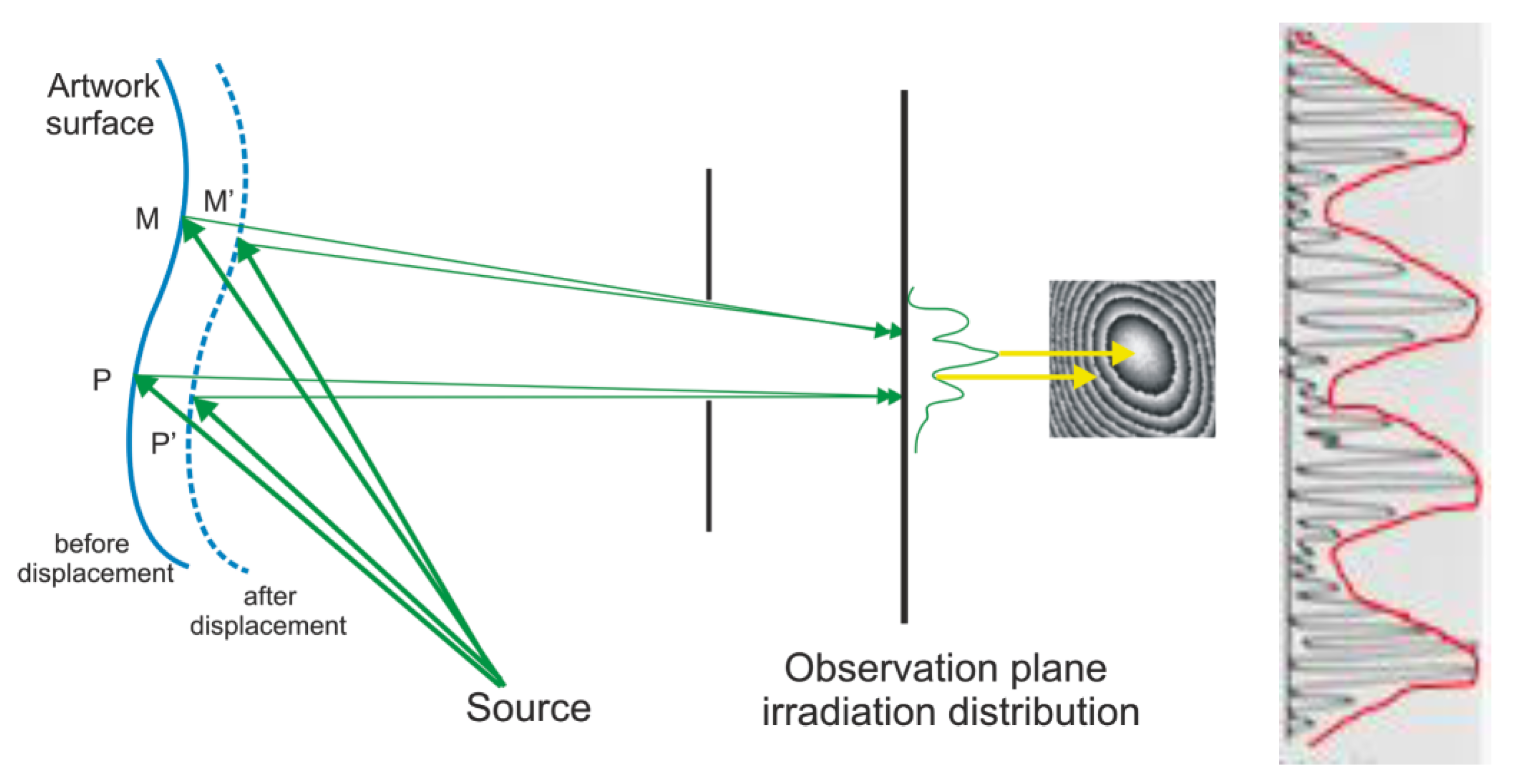
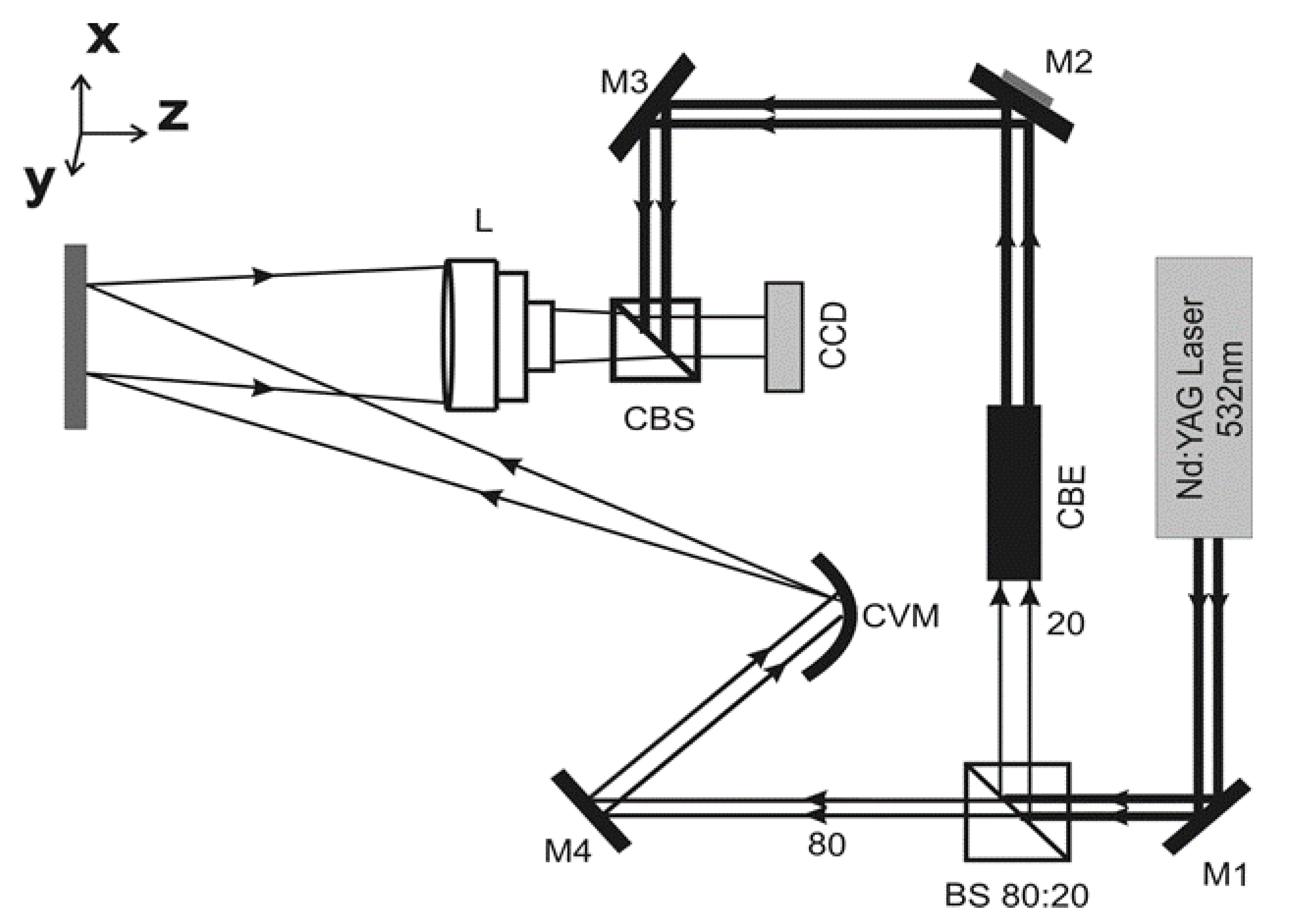
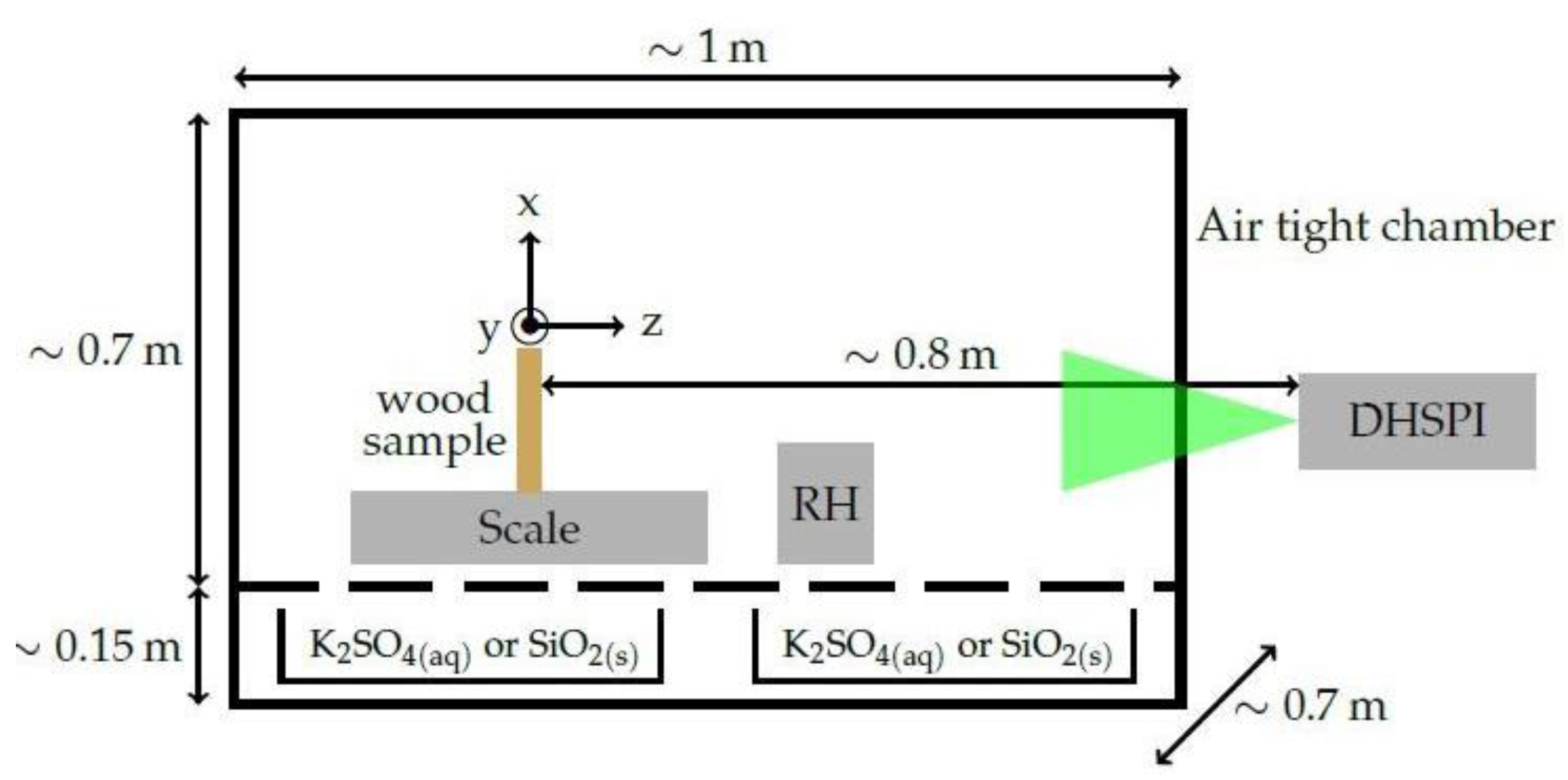
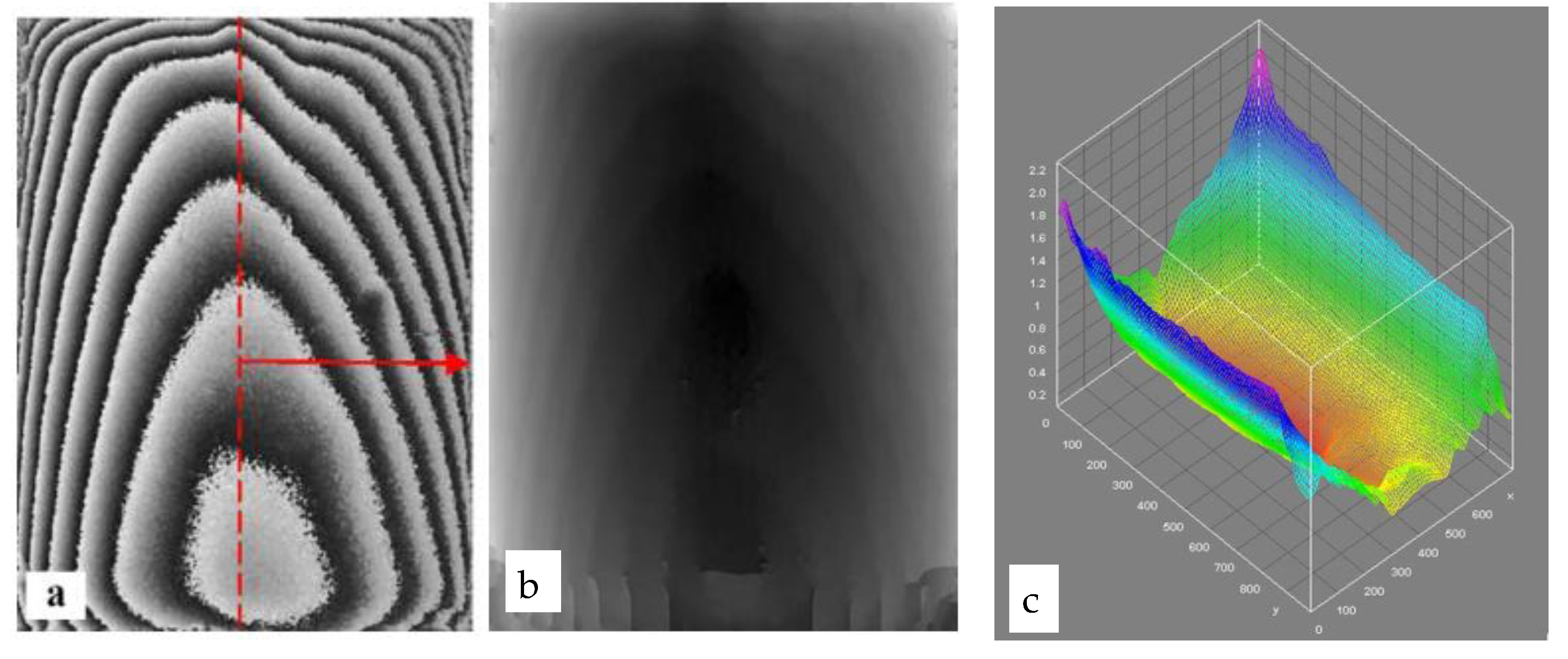
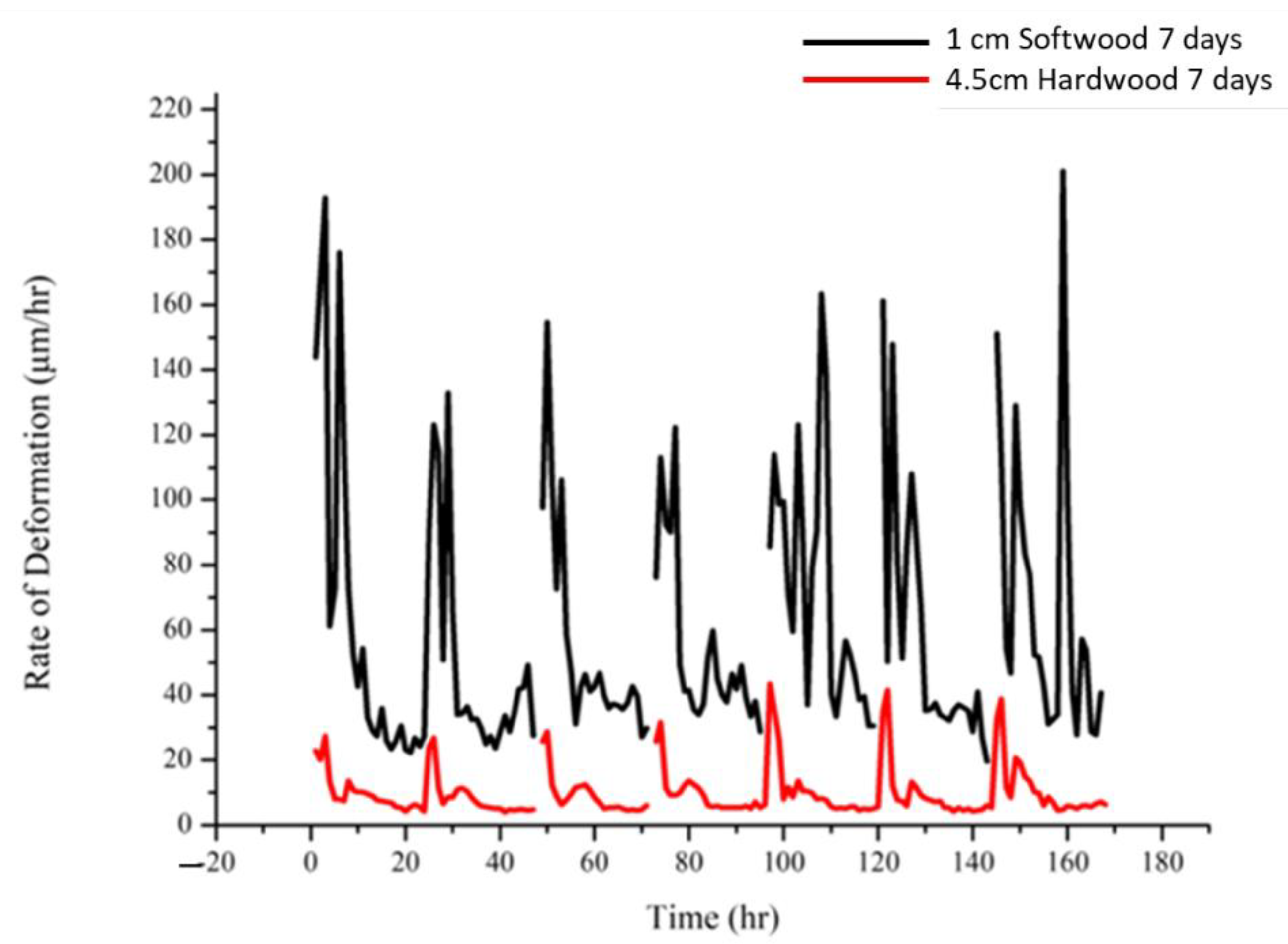

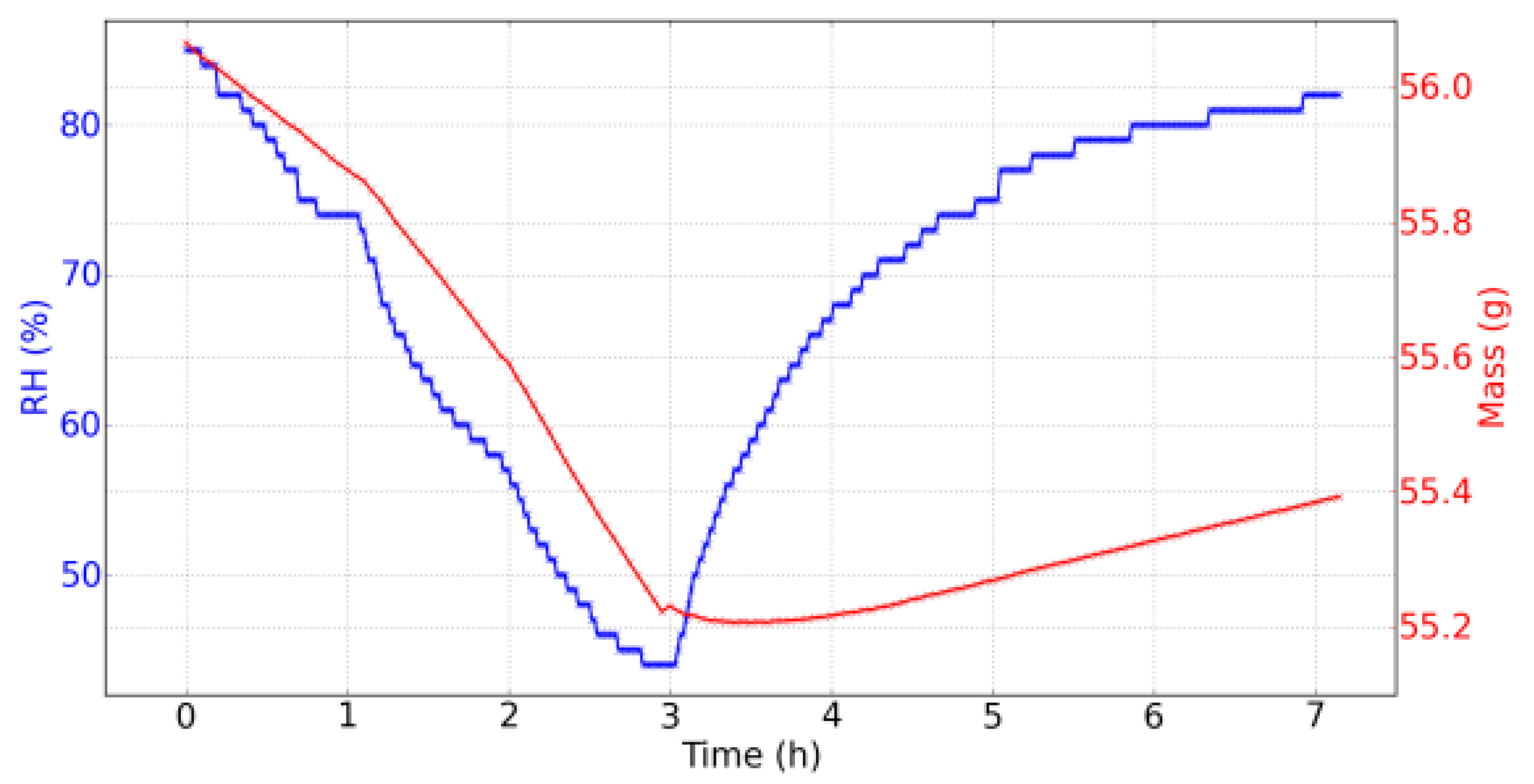
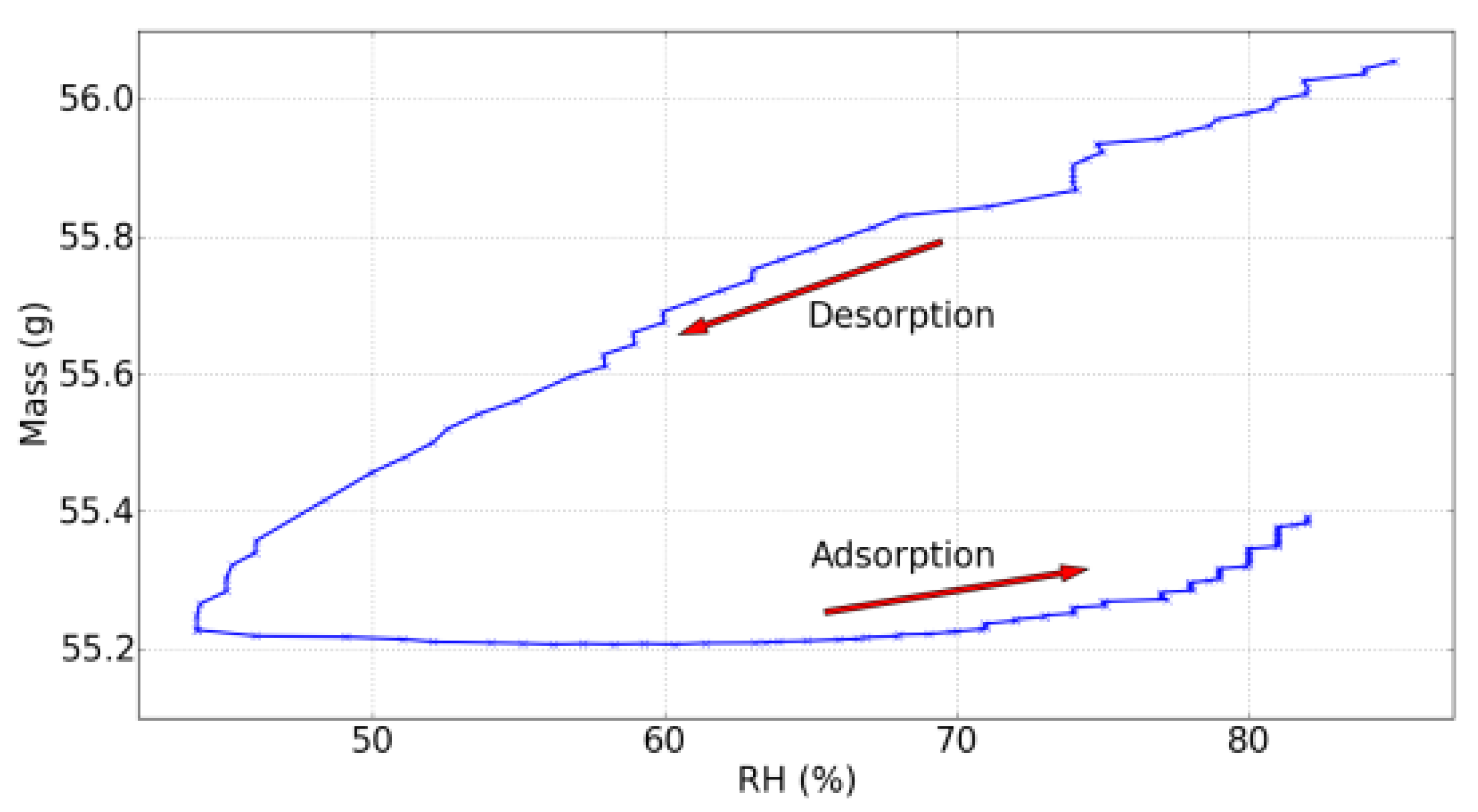

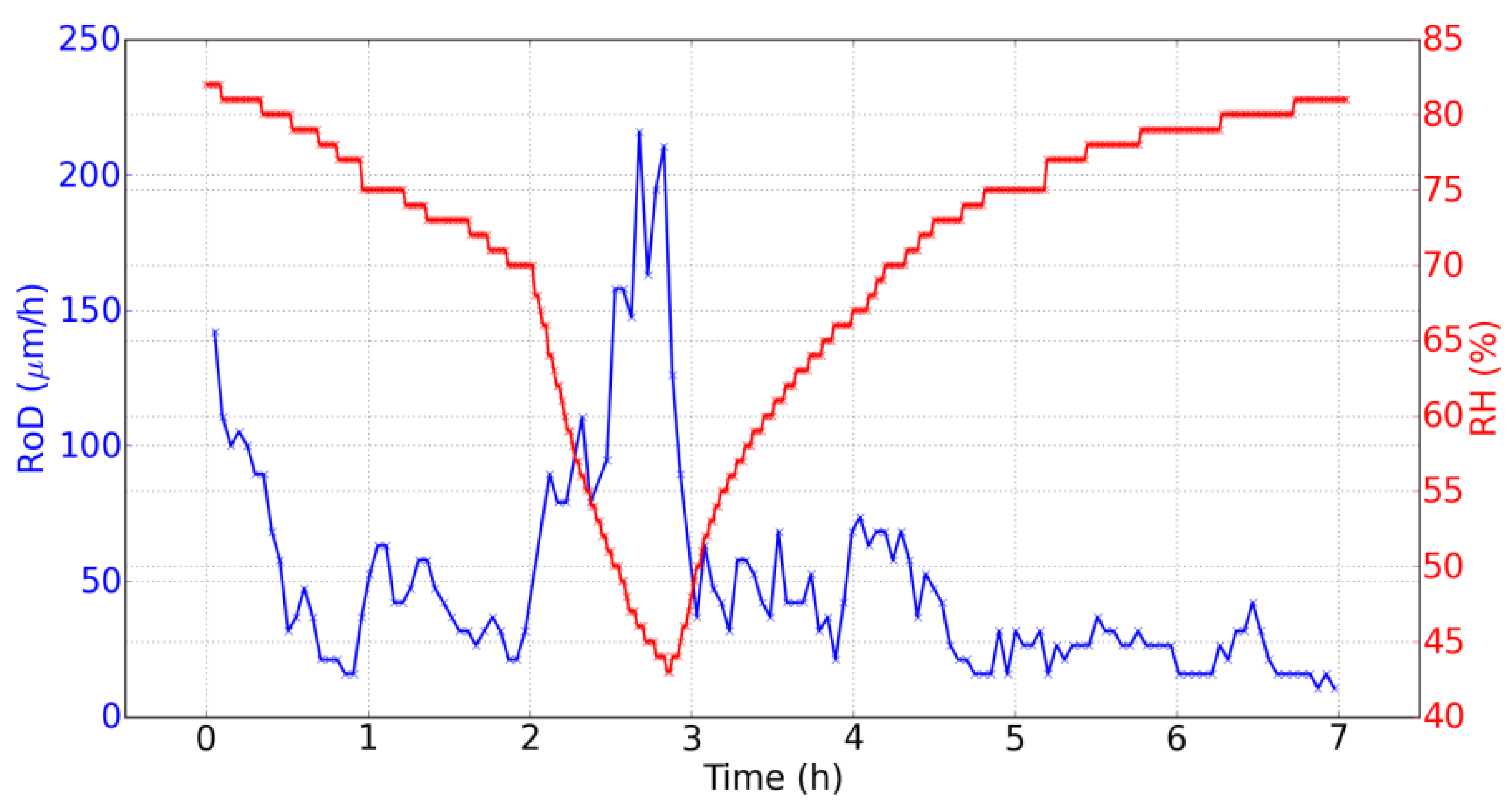
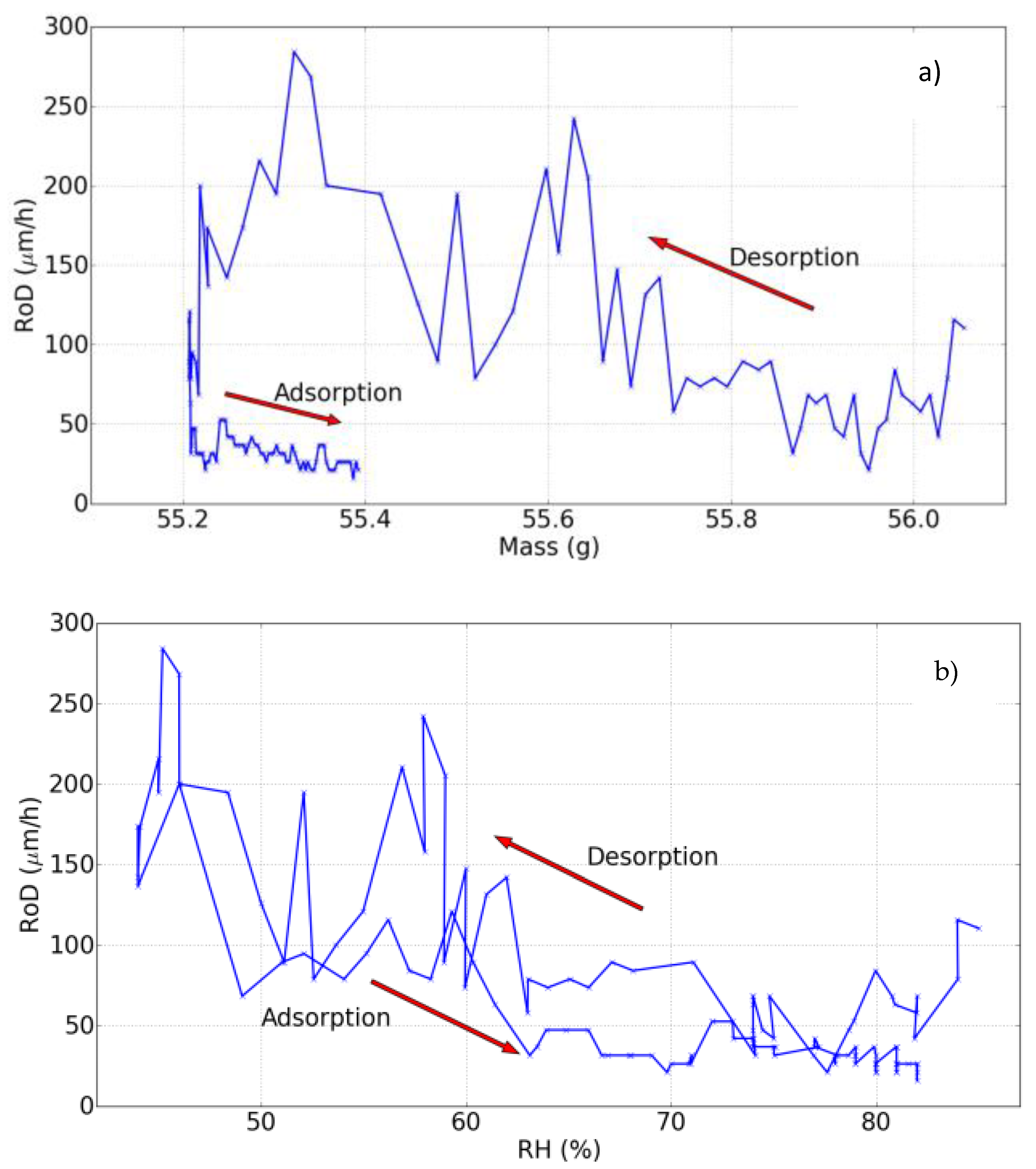
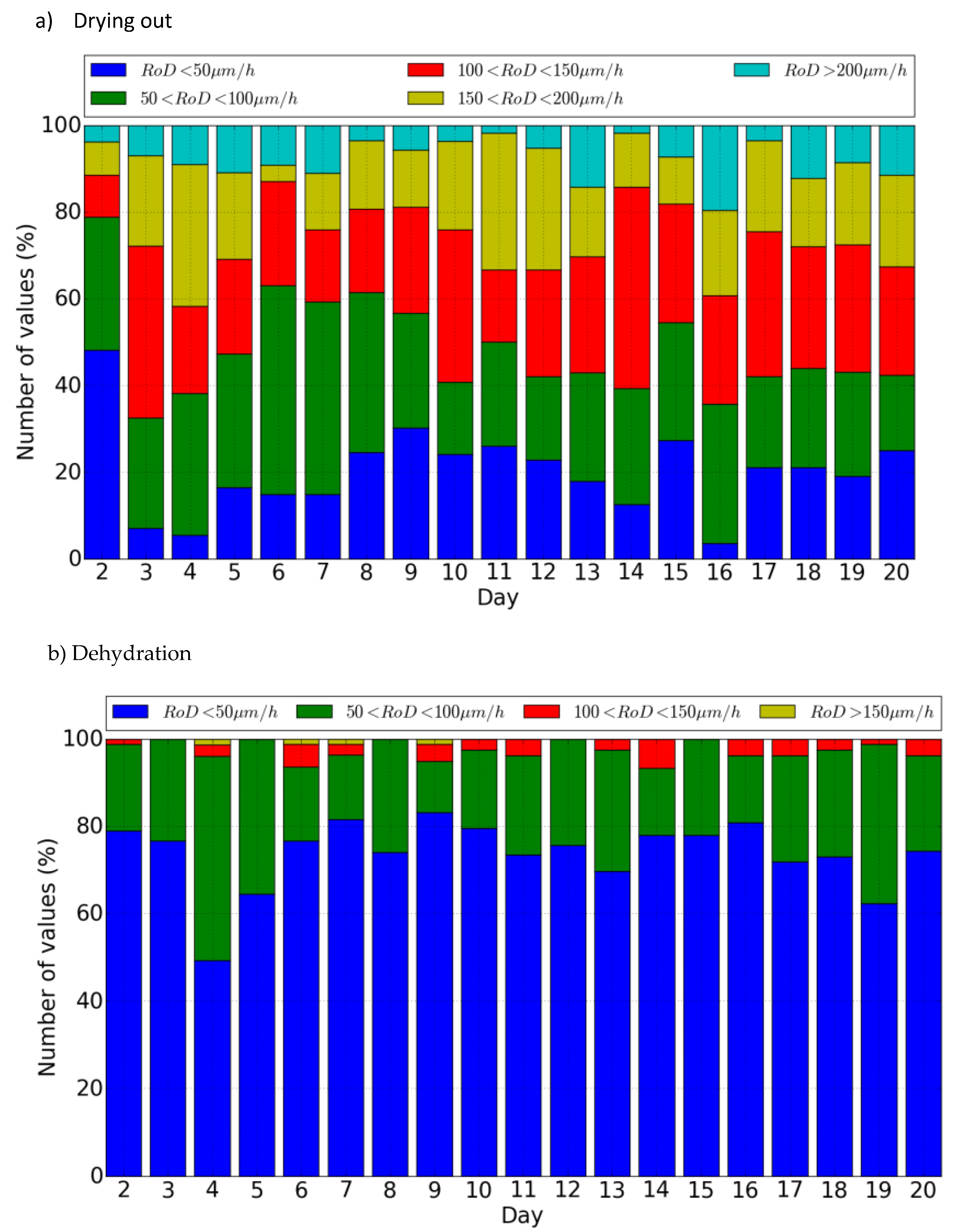
Disclaimer/Publisher’s Note: The statements, opinions and data contained in all publications are solely those of the individual author(s) and contributor(s) and not of MDPI and/or the editor(s). MDPI and/or the editor(s) disclaim responsibility for any injury to people or property resulting from any ideas, methods, instructions or products referred to in the content. |
© 2022 by the author. Licensee MDPI, Basel, Switzerland. This article is an open access article distributed under the terms and conditions of the Creative Commons Attribution (CC BY) license (https://creativecommons.org/licenses/by/4.0/).
Share and Cite
Tornari, V. Interferometric Quantification of the Impact of Relative Humidity Variations on Cultural Heritage. Heritage 2023, 6, 177-198. https://doi.org/10.3390/heritage6010009
Tornari V. Interferometric Quantification of the Impact of Relative Humidity Variations on Cultural Heritage. Heritage. 2023; 6(1):177-198. https://doi.org/10.3390/heritage6010009
Chicago/Turabian StyleTornari, Vivi. 2023. "Interferometric Quantification of the Impact of Relative Humidity Variations on Cultural Heritage" Heritage 6, no. 1: 177-198. https://doi.org/10.3390/heritage6010009
APA StyleTornari, V. (2023). Interferometric Quantification of the Impact of Relative Humidity Variations on Cultural Heritage. Heritage, 6(1), 177-198. https://doi.org/10.3390/heritage6010009






